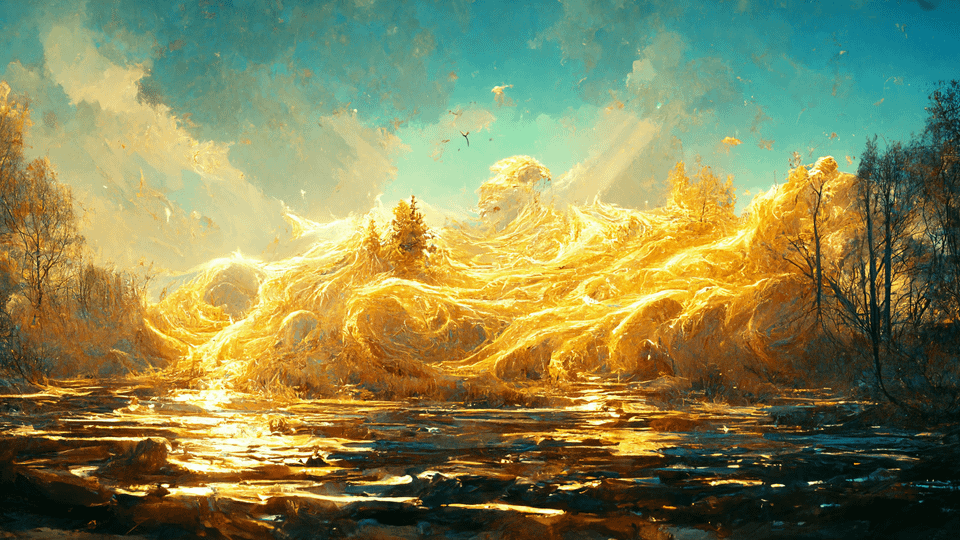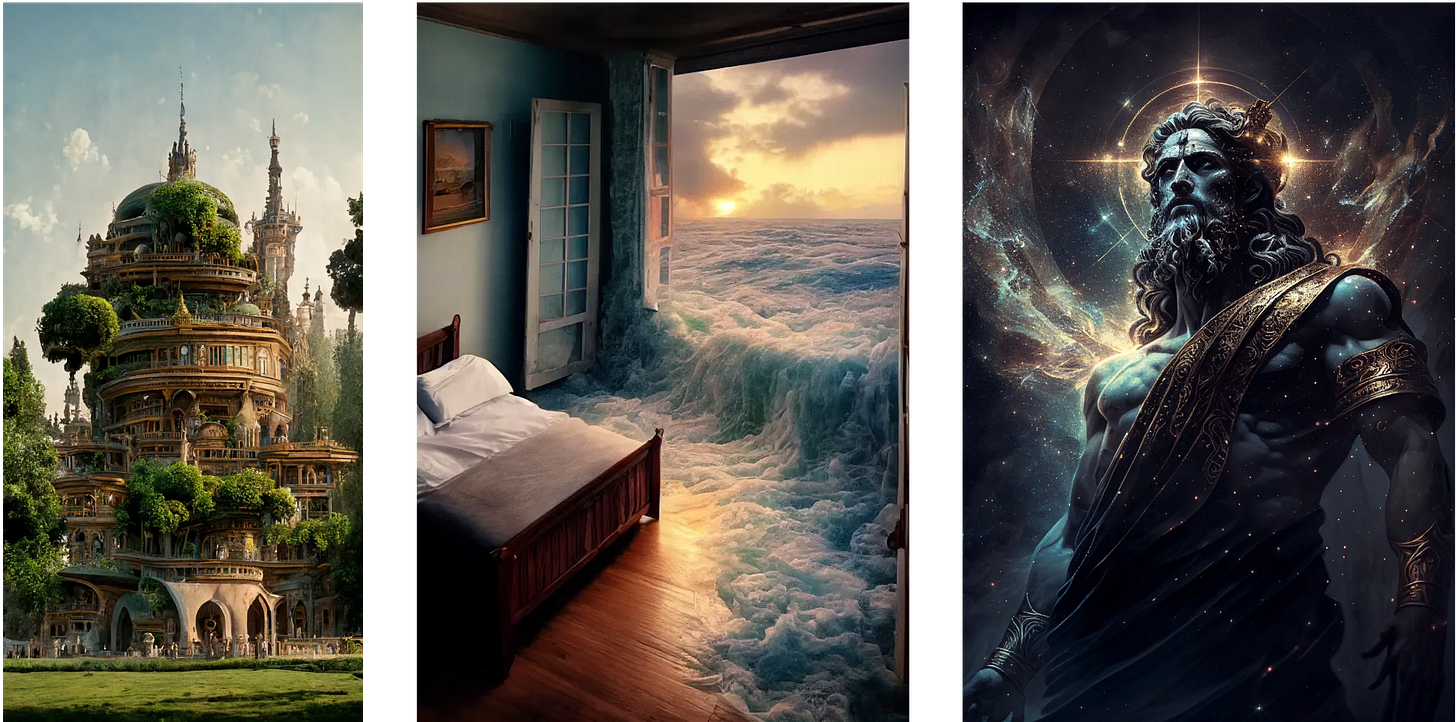Issue #8: AI Art in Design: The Creative Revolution
AI art has recently seen astronomical leaps and bounds. How can we unleash its potential in art and design?
Hi there! 👋
Welcome to the eighth issue of [Navigating] Design at Berkeley, Design at Berkeley’s newsletter, and blog about navigating design at UC Berkeley!
This issue covers:
What is AI Art?
How is design involved and what are its use cases?
Why is this intersection important?
Resources for you to learn more and get involved!
But first, some quick announcements – we have two major events this month!
Be sure to follow us on instagram to stay up to date → instagram.com/designatberk
🎨 HEX x Design @ Berkeley
Collaborating with Design @ Berkeley, Innovative Design is hosting its semesterly HEX event!
Join us this week from April 15-16th for a series of free creative workshops hosted by students from Innovative Design and Design at Berkeley such as Intro to UI/UX! 🌷 Topics include graphic design, web design, photography, video production, and more!
Workshops are 1 hour long each, running from:
Saturday, April 15, 12 PM - 6 PM @ SOCS 15
Sunday, April 16, 12 PM - 6 PM @ SOCS 166
🖊️ Designathon — Sponsored by Bumble and Adobe! [Invention Corps x Design @ Berkeley]
Invention Corps and Design @ Berkeley are hosting a Designathon – There will be prizes sponsored by Bumble and Adobe!
An all-day design sprint, similar to a hackathon but geared towards human-centered design. All UC Berkeley student designers, undergrad and grad, will be drawn upon for this event, split into teams, and tasked with a prompt that they seek to solve by the end of the day! There will be prizes, raffles, and merch giveaways! This event will be held on Sunday, April 16th, from 11am-6pm PST on campus. RSVP Now! → https://forms.gle/RbwRKP2ZtTDppxUFA
👩🏻🏫 Design Advisors
Design @ Berkeley free mentorship resource!
Looking to get mentorship in design? Check out our new advisor list here https://www.designatberkeley.com/resources/advisors. Read their bios for what specific skill sets and areas of expertise they’re willing to advise on and reach out to them!
What is Generative AI Art?
Generative AI art combines human creativity with the assistance of AI technology to create artwork or assist in the creative process. Rather than relying solely on an artist's skill and creativity, the machine generates an output based on the artist's inputs and parameters. In recent years, there have been remarkable breakthroughs in such technology, with the emergence of AI art generators such as Midjourney, DALLE-2, and Stable Diffusion. Here are some examples of what these AI models are capable of outputting.
How is design involved, what are its use cases?
AI art is a contentious topic when it comes to defining it as "true art," but regardless of the debate, its users can benefit greatly from its applications. For designers, visual communication plays a crucial role. What previously would have taken several hours or even days to draw, model, and render can now be generated in just a matter of minutes.
Let’s take Midjourney for example. If you wanted to generate a picture of a snake, you can prompt the Midjourney’s AI model with the desired specifications by inputting keywords such as:
“/prompt snake with dragon horns, no legs, black scales with red and gold patterning, colorful, beautiful eyes, beauty, dynamic full body, hyper realistic, 4K quality”
and you would get something like this:
These art tools can enable students to create visual styles and experiment with new art techniques they may not have even known existed – all while simultaneously enhancing workflow. This can especially help budding designers and artists to broaden their artistic horizons and develop a unique artistic sense and style. Through plain text alone, artists can tap into an infinite well of inspiration at their fingertips. Below are some more examples of the things you can create with AI art generators.
Digital Art and Web Design

Architecture and Interior Design

While generative AI has already begun revolutionizing the way we interact with visual information, it is just one of many use cases for designers.
Here are some more ways to leverage AI art technology:
Automating Busywork
AI is really good at completing repetitive, time-consuming, and noncreative tasks. Training algorithms can automate a lot of a designer’s more mundane tasks such as:
Layout Design: font styles, image placement, and column placement
Image Editing: removing backgrounds, adjusting color saturation, and cropping
Color selection: color palettes
Data visualization: chart/graph generation
Using AI to Brainstorm
With its unprecedented generative ability, AI can significantly enhance the ideation process in design work. Generative AI tools can be paired with traditional product or concept ideation techniques such as moodboards and concept sketching to yield a greater amount of insights on variations on the product/concept outputs.
Processing huge amounts of data
In the future, a big portion of data analysis and collection will become automated by AI. For designers, AI can assist in methods such as A/B testing, which will start happening without any human mediation. Algorithms will be able to:
Detect potential opportunities for product optimization
Comprehend the specific optimization method required (substitute a term, alter button color, rearrange page modules, etc)
Make modification and execute an A/B test with those changes
Evaluate the outcomes and determine the superior version
Revise the product with the latest version and repeat.
Beyond a tool for artists and designers, AI art makes visual art more accessible to the general public. It empowers students with limited artistic abilities to produce high-quality expressions beyond their own capabilities, enabling them to better visualize their ideas. This could perhaps help raise the level of effectiveness of communication with peers on teams and projects. AI art tools can provide students with access to a wide range of media, from 2D and 3D graphics to animations and virtual reality. This can help them create more engaging and immersive visuals that can enhance their videos and presentations.
Why is this intersection important?
AI art has become the new meta for designers as an incredibly useful tool for optimizing efficiency and workflow. It is important to note that while AI may be able to create work efficiently, the quality of work will never completely satisfy a client, as it lacks the empathy and understanding of the relationship fostered between the product and its users. As such, generative AI programs serve as another skill to be mastered and utilized, a helpful aid rather than a replacement of the artist themselves. To stay relevant in this rapidly-evolving landscape, it's crucial to adapt and embrace the opportunities that AI offers. As the saying goes:
The advent of advanced AI models such as GPT-4, capable of processing both text and images as prompts, signifies that we have only begun to explore the potential of this technology. With each iteration, these models grow more sophisticated and powerful, paving the way for a new era of creativity and innovation.
Resources for you to learn more and get involved!
Curious how AI art generators work?
Check out this article: Medium
Want to learn more about the potential of AI-Generated Art?
Check out this article: Rise Visible
Interested in learning more about AI art in architectural design?
Check out this article: Tatler
The following are links to various AI art generators:
Midjourney: https://www.midjourney.com
Stable Diffusion: https://stablediffusionweb.com
NightCafe: https://nightcafe.studio
Playground AI: https://playgroundai.com









